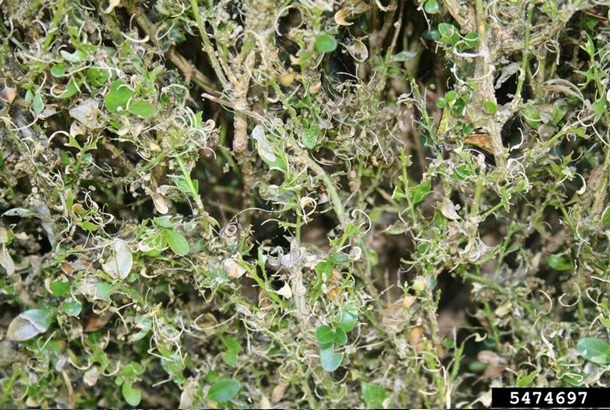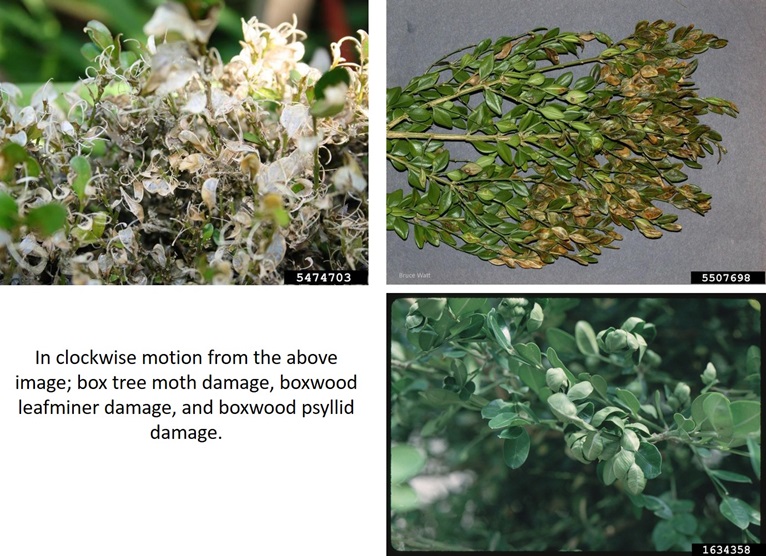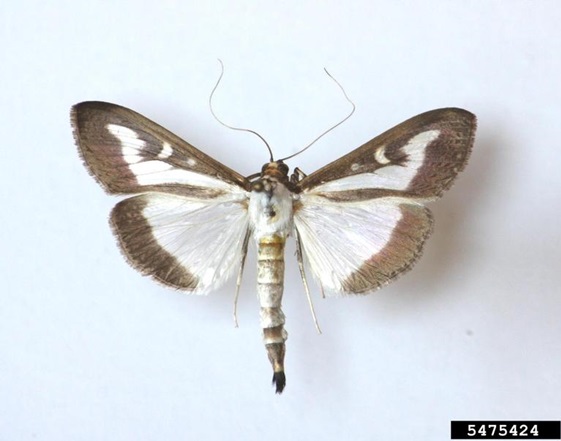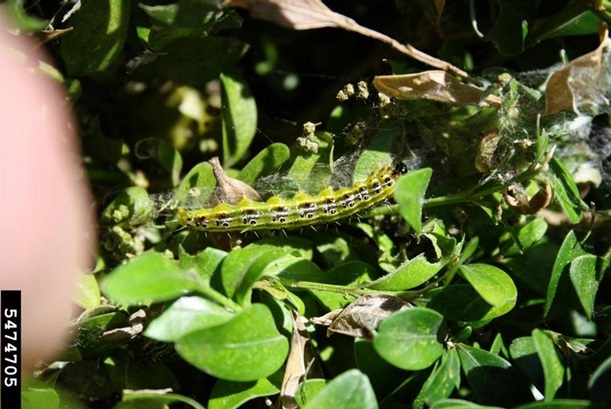Box Tree Moth - Invasive Pest of Boxwoods
ENTFACT-464: Box Tree Moth - Invasive Pest of Boxwoods | Download PDF
Jonathan L. Larson, Extension Specialist
University of Kentucky College of Agriculture
Fast Facts
- Box tree moth is an invasive caterpillar pest that in other areas is a major pest of boxwoods. It was previously known to be established in Ontario, Canada but in May 2021 was found in Michigan, Connecticut, and South Carolina at retail facilities that had received boxwoods from a nursery in Ontario. Additionally, in July 2021 box tree moth adults were confirmed in parts of Western New York near the Canadian border.
- The caterpillar stage feeds mainly on leaves but can also produce lethal damage to plants by feeding on the bark. The most common symptoms are papery leaves and webbing on the plant.
- If you suspect you have found box tree moth, please alert the Entomology Department or the Office of the State Entomologist.

Figure 1. Figure 1: Box tree moth caterpillars can induce damage like papery leaves and strip leaves to the midrib. Older caterpillars will build webs as well. These caterpillars are capable of killing boxwood plants. (Photo: Ferenc Lakatos, University of Sopron, Bugwood.org).
Potential Hosts
Thus far, box tree moth has only been observed to feed on boxwood plants in the genus Buxus. Currently, there are no known resistant varieties of boxwood.
Symptoms and Pest Description
Box tree moth larvae feed on the leaves and the bark of boxwood plants. The younger larvae feed on the undersides of leaves, creating a papery or peeling appearance. As they mature, they will feed on entire leaves, leaving behind only the midrib. As the plant is defoliated, the larvae will move to feed on the bark, girdling and possibly killing the plant. Older caterpillars also produce noticeable webbed enclosures. These are messy and may contain the caterpillar, its frass, and old cast off “skins”.
Boxwoods are also hosts to boxwood leafminers and boxwood psyllids that may leave behind damage. Box tree moth damage is different in comparison to our native pests. Boxwood leafminers cause the leaves to appear blistered as they feed from the inside. There is also an orange or bronzed color caused by their damage, which is found in the newest growth. Similarly, boxwood psyllid prefers to attack the newest foliage, but they cause the leaves to cup inward on themselves.

Figure 2. Figure 2: Box tree moth is not the only pest of boxwoods, though their damage looks different than the symptoms left behind by boxwood leafminer and boxwood psyllid. Leafminers create blistered, bronze, leaves in the newer growth while psyllids cause the newest growth to become cupped. (Photos by Ferenc Lakatos, University of Sopron Bruce Watt, University of Maine, and Penn State Department of Plant Pathology & Environmental Microbiology Archives, Bugwood.org)
In its final instar, the box tree moth caterpillar is about a half inch long. They are primarily yellow green in color, with black and white stripes that run vertically down the body on each side. On each abdominal segment there is a pair of black dots.
The adult moth is broadly fan shaped. On most adults, the exterior margins of their wings are brown and there is an inner white triangle that spans the wings and body. Some adults may be completely brown. The box tree moth superficially resembles the melonworm moth in coloration and the patterns on their wings. The box tree moth has white comma like markings near the wing margins that the melonworm lacks.

Figure 3: Box tree moth adults are fan shaped and have brown margins on their wings. The inner portions of the wing are white and make a triangle when at rest. Box tree moth adults tend to also have a white comma-like shape on the wing. (photo by Szabocls Sáfián, University of West Hungary, Bugwood.org)
Life Cycle in Kentucky
It is possible for this pest to have 1-5 generations per year, depending on the climate surrounding the population of moths. It is estimated that in Ontario, there are two generations produced per year. It is likely that if box tree moth were to become established in Kentucky that this would be the case here as well.
This pest overwinters as a caterpillar and resumes feeding in the early spring. They will stop feeding for 6-8 weeks and then resume feeding again in May. Following this, they will pupate, and the adults will emerge to reproduce. Their subsequent larvae would be the overwintering generation.

Figure 4: The mature larva of a box tree moth is about ½ inch long, with yellow-green coloration, black and white stripes down their sides, and a pair of black dots on each abdominal segment. (Photo by Ferenc Lakatos, University of Sopron, Bugwood.org)
Management
In Europe, Spinosad and Bacillus thuringiensis have been used successfully against this pest. Aside from these organic options, chlorantraniliprole and pyrethroid insecticides can also be effective, though that success is dependent upon proper timing. Possible control measures would have to be evaluated for Kentucky should this pest ever appear in the bluegrass state.
What To Do If You Believe You Have Found This Pest
This invasive species is originally from Asia and has been highly problematic in many European nations. Previously, the only North American site was in Ontario, Canada. However, that changed in 2021 when reports were released that this pest had been discovered in New York, Michigan, Connecticut, and South Carolina.
If you fear you have spotted damage from this pest or have captured a specimen, please contact us at the Department of Entomology or reach out to the Office of the State Entomologist to begin the process of confirmation. The easiest way to do is to email, reportapest@uky.edu We are hopeful we can keep this invader from the state, and we appreciate receiving tips from the field.
Issued: 02/22
CAUTION! Pesticide recommendations in this publication are registered for use in Kentucky, USA ONLY! The use of some products may not be legal in your state or country. Please check with your local county agent or regulatory official before using any pesticide mentioned in this publication.
Of course, ALWAYS READ AND FOLLOW LABEL DIRECTIONS FOR SAFE USE OF ANY PESTICIDE!
